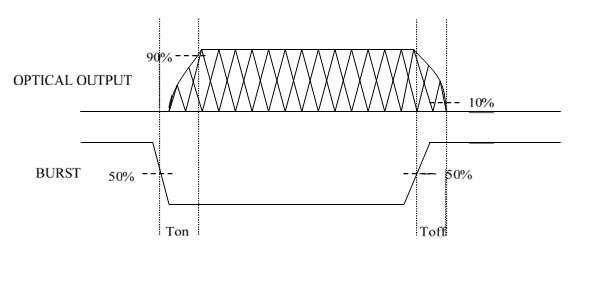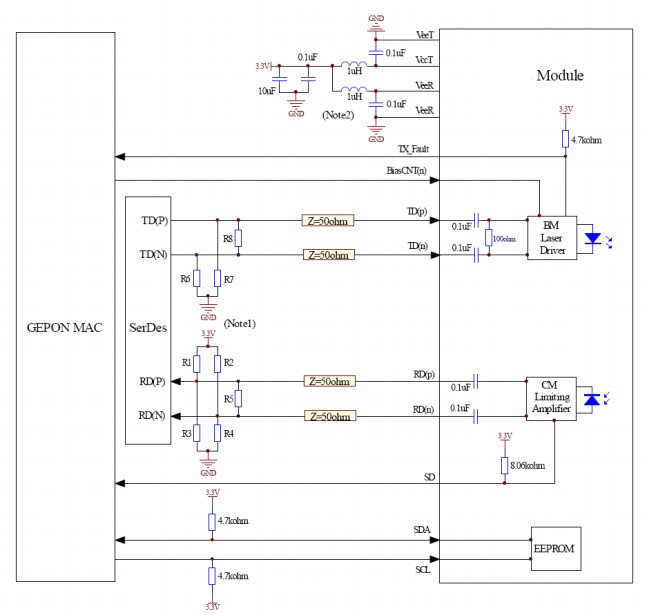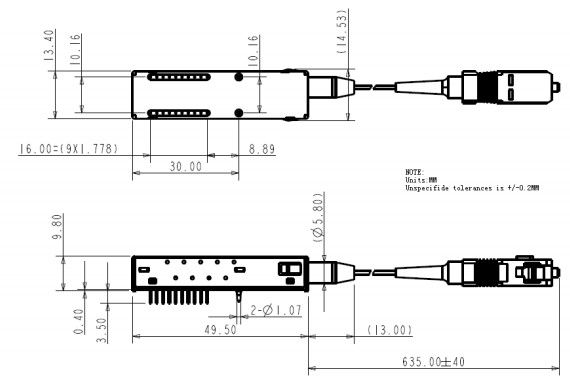
- Sopto Home
-

- SPEU-F3411-PE2DB GEPON ONU SFF 2X10
- Fiber Optic Transceiver Module
- High Speed Cable
- Fiber Optical Cable
- Fiber Optical Patch Cords
- Splitter CWDM DWDM
- PON Solution
- FTTH Box ODF Closure
- PCI-E Network Card
- Network Cables
- Fiber Optical Adapter
- Fiber Optical Attenuator
- Fiber Media Converter
- PDH Multiplexers
- Protocol Converter
- Digital Video Multiplexer
- Fiber Optical Tools
- Compatible
- Fiber Optic Transceiver Module
- High Speed Cable
- Fiber Optical Cable
- Fiber Optical Patch Cords
- Splitter CWDM DWDM
- PON Solution
- FTTH Box ODF Closure
- PCI-E Network Card
- Network Cables
- Fiber Optical Adapter
- Fiber Optical Attenuator
- Fiber Media Converter
- PDH Multiplexers
- Protocol Converter
- Digital Video Multiplexer
- Fiber Optical Tools
- Compatible
SPEU-F3411-PE2DB GEPON ONU SFF 2X10

SPEU-F3411-PE2DB
GEPON ONU SFF 2X10
Features
Single fiber Bi-Directional transceiver with single SC/PC pigtail
1310nm burst-mode 1.25Gbps transmitter with DFB LD laser
1490nm continuous-mode 1.25Gbps receiver with APD-TIA
Burst mode: “low” active
Complies with IEEE Std 802.3ah™ -2004
Digital diagnostic interface compliant with SFF-8472 Rev 9.5, Digital Diagnostic Monitoring (DDM) with external calibration
3.3V Single power supply
Complies with RoHS directive
Operating case temperature:
Standard : 0 to +70°C
Applications
IEEE 802.3ah 1000BASE-PX20++
GE-PON ONU
Burst mode application.
FTTx WDM Broadband Access
Description
The SPEU-F3411-PE2DB Bi-Directional Transceiver is the high performance module for single fiber communications by using 1310nm 1.25Gbps burst mode transmitter and 1490nm 1.25Gbps continuous receiver. It is Optical Network Unit (ONU) for IEEE Std 802.3ah™ -2004. The optical transceiver is compliant with Multi-Source Agreement (MSA) Small Form Factor (SFF) 2x10 footprint. The transmitter section uses a 1310nm DFB laser diode with automatic power control (APC) function and temperature compensation circuitry to ensure stable extinction ratio overall operating temperature range, and full IEC825 and CDRH class 1 eye safety. The receiver has a hermetically packaged PIN-TIA (trans-impedance amplifier) pre-amplifier and a limiting amplifier with CML compatible differential outputs.
Absolute Maximum Ratings
|
Parameter |
Symbol |
Min. |
Max. |
Units |
Notes |
|
Storage Temperature |
Tst |
-40 |
+85 |
°C |
- |
|
Operating Case Temperature |
Tc |
0 |
70 |
°C |
- |
|
Operating Humidity |
RH |
5 |
90 |
% |
Non-condensing |
|
Input Voltage |
- |
GND |
Vcc |
V |
- |
|
Power Supply Voltage |
Vcc-Vee |
0 |
3.6 |
V |
- |
Recommended Operating Conditions
|
Parameter |
Symbol |
Min |
Typical |
Max |
Unit |
|
Operating Case Temperature |
Tc |
0 |
- |
+70 |
°C |
|
Power Supply Voltage |
Vcc |
3.13 |
3.3 |
3.47 |
V |
|
Power Supply Current |
Icc |
- |
- |
300 |
mA |
Optical and Electrical Characteristics
|
Parameter |
Symbol |
Min |
Typical |
Max |
Unit |
Notes |
||
|
Transmitter |
||||||||
|
TX Data Rate |
RT |
|
1.25 |
|
Gb/S |
|
||
|
Centre Wavelength |
λc |
1276 |
1310 |
1356 |
nm |
|
||
|
Spectral Width |
∆λ |
|
|
2.8 |
nm |
|
||
|
Total Jitter |
TJ |
|
|
0.35 |
dB |
|
||
|
Side Mode Suppression Ratio |
SMSR |
30 |
|
|
|
|
||
|
Average Output Power |
Pout |
2 |
|
5 |
dBm |
1 |
||
|
Average Launch Power-OFF Transmitter |
Poff |
|
|
-45 |
dBm |
|
||
|
Extinction Ratio |
ER |
9 |
|
|
dB |
|
||
|
Burst Enable Delay |
Ton |
|
|
32 |
ns |
Fig.1 |
||
|
Burst Disable Delay |
Toff |
|
|
32 |
ns |
Fig.1 |
||
|
Relative Intensity Noise |
RIN15_OM |
|
|
-115 |
Hz/Hz |
|
||
|
Transmitter & Dispersion Penalty |
TDP |
|
|
1.8 |
dB |
|
||
|
Optical Eye Diagram |
Compliant with of IEEE802.3ah (Fig.60-6) transmitter eye ask definition |
|||||||
|
Optical Rise/ Fall Time (20%~80%) |
tr/tf |
|
|
260 |
ps |
|
||
|
Data Input Swing Differential |
VIN |
200 |
|
1600 |
mV |
2 |
||
|
Input Differential Impedance |
ZIN |
90 |
100 |
110 |
Ω |
|
||
|
Burst |
Disable |
|
2.0 |
|
Vcc |
V |
|
|
|
Enable |
|
0 |
|
0.8 |
V |
|
||
|
TX Fault |
Fault |
|
2.0 |
|
Vcc |
V |
|
|
|
Normal |
|
0 |
|
0.8 |
V |
|
||
|
Receiver |
||||||||
|
RX Data Rate |
Rr |
|
1.25 |
|
Gb/S |
|
||
|
Centre Wavelength |
λc |
1480 |
|
1500 |
nm |
|
||
|
Receiver Sensitivity (BOL) |
Sen |
|
|
-30 |
dBm |
3 |
||
|
Receiver Overload |
Sat |
-8 |
|
|
dBm |
3 |
||
|
Receiver Reflectance |
|
|
|
-12 |
dB |
|
||
|
Signal Detect De-Assert |
SDD |
-44 |
|
|
dBm |
4 |
||
|
Signal Detect Assert |
SDA |
|
|
-30 |
dBm |
|
||
|
Signal Detect Hysteresis |
SDH |
0.5 |
|
6 |
dB |
4 |
||
|
Output Differential Impedance |
ZIN |
90 |
100 |
110 |
Ω |
|
||
|
Data Output Swing Differential |
VOUT |
400 |
|
1400 |
mV |
|
||
|
SD Output Voltage |
High |
|
2.0 |
|
VCC |
V |
|
|
|
Low |
|
0 |
|
0.8 |
V |
|
||
Notes:
1. The optical power is launched into SMF.
2. PECL input, internally DC-coupled and terminated.
3. Measured with a PRBS 2 -1 test pattern @1250Mbps, BER ≤1×10
Diagnostics
|
Parameter |
Range |
Unit |
Accuracy |
Calibration |
|
Temperature |
0 to +70 |
°C |
±3°C |
Internal/External |
|
Voltage |
3.0 to 3.6 |
V |
±3% |
Internal/External |
|
Bias Current |
0 to 100 |
mA |
±10% |
Internal/External |
|
TX Power |
2 to 5 |
dBm |
±3dB |
Internal/External |
|
RX Power |
-30 to -8 |
dBm |
±3dB |
Internal/External |
Transmitter Burst Mode Timing Characteristics
Definition of Burst Enable Delay (Ton) and Burst Disable Delay (Toff)

Digital Diagnostic Memory Map
The transceivers provide serial ID memory contents and diagnostic information about the present operating conditions by the 2-wire serial interface (SCL, SDA).
The diagnostic information with internal calibration or external calibration all are implemented, including received power monitoring, transmitted power monitoring, bias current monitoring, supply voltage monitoring and temperature monitoring.
The digital diagnostic memory map specific data field defines as following.

Pin Definitions
Pin Diagram
.jpg)
Pin Descriptions
|
Pin |
Signal Name |
Description |
Notes |
|
1 |
NC |
Not Connect |
|
|
2 |
VEER |
Receiver Ground |
|
|
3 |
VEER |
Receiver Ground |
|
|
4 |
NC |
Not Connect |
|
|
5 |
NC |
Not Connect |
|
|
6 |
VEER |
Receiver Ground |
|
|
7 |
VCCR |
Receiver Power Supply |
|
|
8 |
SD |
Signal Detect Output |
Note1 |
|
9 |
RD- |
Inv. Received Data CML Output, Internal AC Coupling |
Note2 |
|
10 |
RD+ |
Received Data CML Output, Internal AC Coupling |
Note2 |
|
11 |
VCCT |
Transmitter Power Supply |
|
|
12 |
VEET |
Transmitter Ground |
|
|
13 |
BURST |
Transmitter Burst Control |
Note3 |
|
14 |
TD+ |
Transmit Data LVPECL Input, Internal AC Coupling |
Note4 |
|
15 |
TD- |
Inv. Transmit Data LVPECL Input, Internal AC Coupling |
Note4 |
|
16 |
VEET |
Transmitter Ground |
|
|
17 |
SCL |
Serial Clock Signal |
Note5 |
|
18 |
SDA |
Serial Data Signal |
Note5 |
|
19 |
TX_F |
TX Fault Alarm, LVTTL Output |
|
|
20 |
TX_SD |
TX Signal Detected |
|
Notes:
Plug Seq.: Pin engagement sequence during hot plugging.
1) Logic 0 indicates loss of signal; Logic 1 indicates normal operation. In the low state, the output will be pulled to less than 0.8V.
2) RD-/+: These are the differential receiver outputs. They are internally AC-coupled 100 differential lines which should be terminated with 100Ω (differential) at the user SERDES.
3) BURST is a TTL input. When it is low, LD is on; when it is high, LD is off.
4) TD-/+: These are the differential transmitter inputs. They are internally AC-coupled, differential lines with 100Ω differential termination inside the module。
5) SCL, SDA should be pulled up with a 4.7k~10kΩ resistor on the host board. The pull-up voltage shall be VccT or VccR.
SCL is the clock line of two wire serial interface for serial ID
SDA is the data line of two wire serial interface for serial ID
Recommended Application Circuit

Mechanical Dimensions

Orderinginformation
| Part Number | Product Description |
| SPEU-F3411-PE2DB | Tx 1310nm, Rx 1490nm, 1.25Gbps/1.25Gbps, 1000BASE-PX20, Withpigtail, Burst low, 0º C~+70º C, DDM |
E-mail:sales@sopto.com







